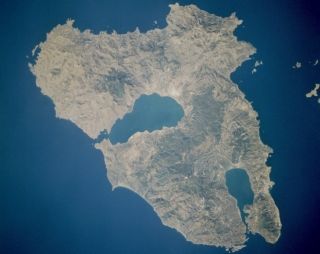Philosophy
How Science Began
In the 4th century BCE, Aristotle took to doing philosophy from the ground up.
Posted March 26, 2023 Reviewed by Devon Frye
Key points
- The great philosopher Aristotle was also a biologist, who studied the flora and fauna of the island of Lesbos.
- Unlike those who came before him, Aristotle privileged observation over theory, and even carried out rudimentary experiments.
- But he did not use controls and relied uncritically on lay testimony, leading to some embarrassing errors.

Around 370 BCE, the 13-year-old Aristotle lost both of his parents. When he turned 17, his guardian sent him to study at Plato’s Academy in Athens. He remained at the Academy for nearly 20 years, only leaving after Plato’s death in 347.
Now in his 37th year, Aristotle travelled to Assos (in modern-day Turkey) to join the court of Hermias of Atarneus, who had studied at the Academy. It seems he exerted a moderating influence on Hermias, who softened his harsh tyrannical rule. But in 344, Hermias was captured and tortured to death by a mercenary in the service of the Persian king Artaxerxes III.
After the death of Hermias, Aristotle’s student Theophrastus invited him to cross over to his native Lesbos. Together, they researched the flora and fauna of the island and its remarkable lagoon, then known as the Pyrrha lagoon, now the Gulf of Kalloni. Supposedly, the more empirical Theophrastus concentrated on the flora while the more speculative Aristotle concentrated on the fauna, so that the one is remembered as the father of botany and the other as the father of zoology. In fact, Theophrastus also wrote about animals, and Aristotle also wrote about plants, but these works have been lost.
Aristotle’s biological works represent the first systematic study of biology and reveal a great deal about the man and his method. They are usually ignored, even though they make up a quarter of his extant corpus, and were revered by naturalists such as Georges Cuvier and Charles Darwin—who, in the year of his death, 1882, wrote to William Ogle that “although Linnaeus and Cuvier have been my two gods… they were mere schoolboys to old Aristotle.”
In his biological works, Aristotle outlines more than five hundred species, some in more detail than others. He describes the chambered stomachs of ruminants, the social organization of bees, and the embryological development of a chick. He notices that some sharks are viviparous, and that whales and dolphins differ from other fish in breathing air and suckling their young. He infers that brood size decreases with body mass, whereas gestation period, and overall lifespan, increase. In a playful aside, he remarks that “after drinking wine, the Indian parrot becomes more saucy than ever.”
For centuries, some of Aristotle’s accounts seemed too fanciful to be true—for instance, that the young of a dogfish grow inside their mother’s body, that the male of the river catfish guards the eggs for 40 or 50 days after the female has left, or that male octopuses have a sperm-transferring tentacle that sometimes snaps off during mating. Each of these marvels had to wait until the nineteenth century to be confirmed.
Unlike Plato, Aristotle privileged observation over theory. Like modern scientists, he began with a systematic gathering of data, and from this data attempted to infer explanations and make predictions. He carried out dissections and even rudimentary experiments such as cutting out the heart of a tortoise to discover that it could still move its limbs for a surprisingly long time.
However, he did not carry out anything like modern case-control studies and relied uncritically on the lay testimony of beekeepers, fishermen, travellers, and the like. This lack of rigour led to some embarrassing errors, such as the claim that lions copulate back-to-back, while bears adopt the missionary position and hedgehogs stand on their hind legs to face each other. Or the claim that the female of several species has fewer teeth than the male. Among these species, he included humans, when he could simply have looked into his wife or daughter's mouth.
Aristotle was not merely doing biology for the sake of science, but for the sake of philosophy. Like Plato, he was searching for universals, but this time from the ground up. “We should,” he said, “venture on the study of every kind of animal without distaste; for each and all will reveal to us something natural and something beautiful." An animal gives birth to the same animal because of its form or ordering pattern—an idea that resonates with modern genetics. Aristotle’s interest in biology informs his theory of the form, which in turn informs his entire physics and metaphysics.
Although he held that all animals have a form, and that the form is transmitted by the male, Aristotle also believed that many lower animals spontaneously generate: that eels grow out of mud, and insect maggots from putrefying flesh, even though Homer had said otherwise—when, in Iliad XIX, Achilles fears that flies will “breed worms” in the corpse of Patroclus. In Aristotle’s defence, he had observed that eels have no gonads, and could hardly have guessed that they only develop them in the course of their epic migration to the Sargasso Sea.
The earliest challenge to spontaneous generation came at late as 1668, when Francesco Redi covered jars of rotting flesh with gauze and found that only the control, that is, the uncovered jars, grew maggots.
Neel Burton is author of The Gang of Three: Socrates, Plato, Aristotle




